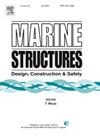优化锚链以减少水下浮式隧道中波浪引起的结构响应
IF 5.1
2区 工程技术
Q1 ENGINEERING, CIVIL
引用次数: 0
摘要
本文研究了水下浮动隧道系泊索的优化设计,以减轻波浪荷载作用下结构的动力响应。通过ABAQUS-AQUA中基于流体动力学的数值模拟,对四种配置进行了评估,从而可以直接比较运动控制性能。双斜系绳系统效率最高,其运动控制机理得到了实验验证。基于这些发现,提出了一个包含多个标准的综合系泊设计过程。认识到仅通过数值模拟确定最优设计参数的困难,介绍了一种简化的解析方法,作为一种有效的替代方法,并通过仿真结果进行了验证。应用该方法,得到了双斜系绳的最优配置,在考虑最大和最小系绳应力、系绳间距为58 m、疲劳条件下,系绳外倾角为27.7°。由于这些参数随环境条件的变化而变化,因此它们的最终确定应遵循实际实施中建议的设计过程。本文章由计算机程序翻译,如有差异,请以英文原文为准。
Optimizing mooring tethers to minimize wave-induced structural responses in submerged floating tunnels
This study investigates optimal mooring tether designs for submerged floating tunnels (SFTs) to mitigate dynamic structural responses under wave loading. Four configurations were assessed through hydrodynamics-based numerical simulations in ABAQUS-AQUA, enabling direct comparison of motion control performance. The doubly-inclined tether system exhibited the highest efficiency, and its motion control mechanism was experimentally validated. Based on these findings, an integrated mooring design process incorporating multiple criteria is proposed. Recognizing the difficulty of determining optimal design parameters solely through numerical simulations, a simplified analytical method is introduced as an efficient alternative and validated against simulation results. By applying this method, an optimal doubly-inclined tether configuration was obtained, with an outside tether inclination angle of 27.7°, determined considering maximum and minimum tether stresses, and a spacing of 58 m between tethers, governed by fatigue. As these parameters vary with environmental conditions, their final determination should follow the proposed design process for practical implementation.
求助全文
通过发布文献求助,成功后即可免费获取论文全文。
去求助
来源期刊

Marine Structures
工程技术-工程:海洋
CiteScore
8.70
自引率
7.70%
发文量
157
审稿时长
6.4 months
期刊介绍:
This journal aims to provide a medium for presentation and discussion of the latest developments in research, design, fabrication and in-service experience relating to marine structures, i.e., all structures of steel, concrete, light alloy or composite construction having an interface with the sea, including ships, fixed and mobile offshore platforms, submarine and submersibles, pipelines, subsea systems for shallow and deep ocean operations and coastal structures such as piers.
 求助内容:
求助内容: 应助结果提醒方式:
应助结果提醒方式:


